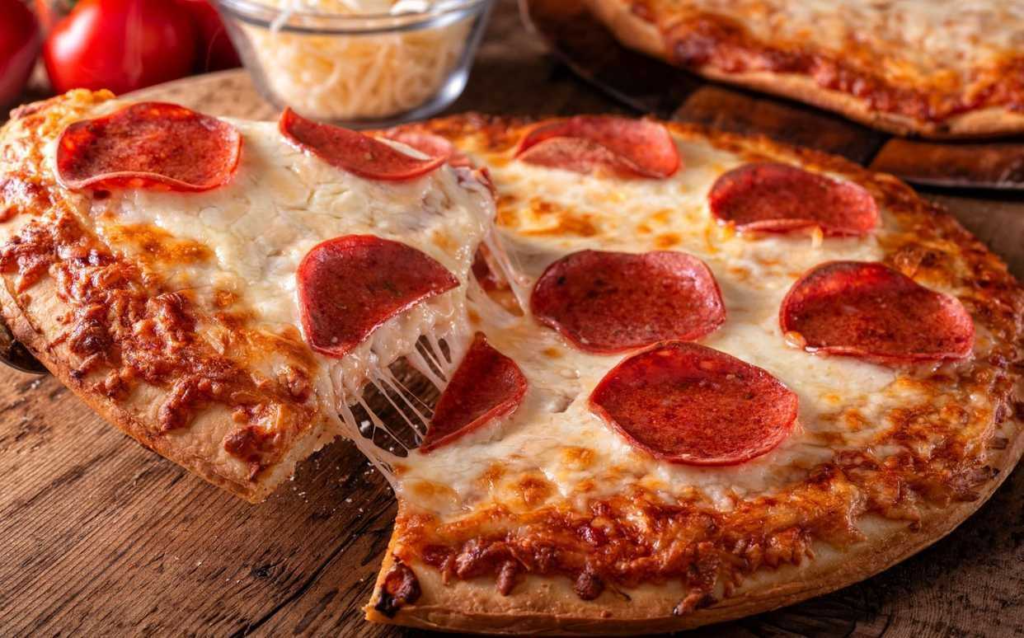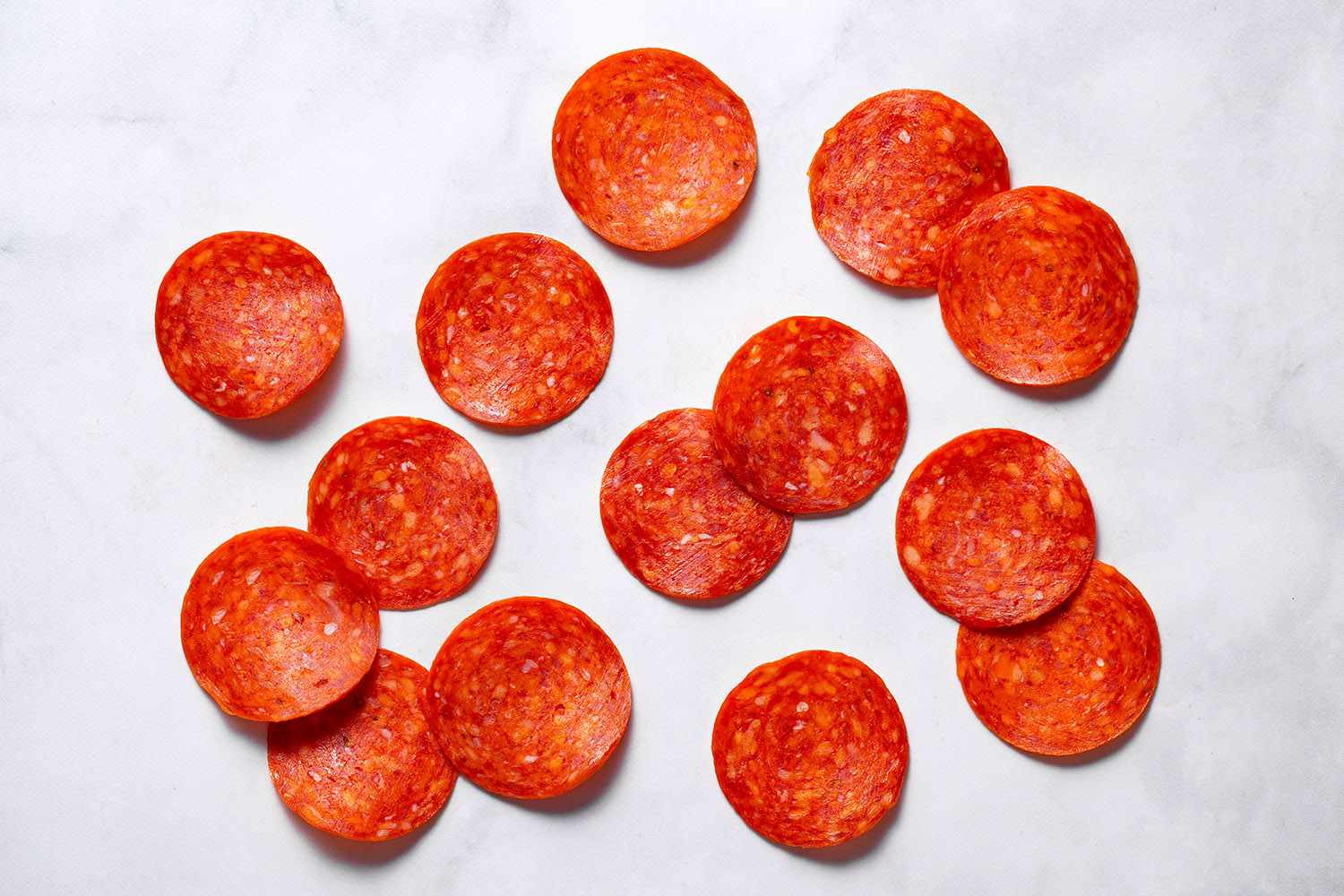Pepperoni is one of the most popular and beloved pizza toppings in the world. With its spicy, smoky, and slightly tangy flavor, this cured meat has become a staple ingredient in American and Italian cuisine. While it is most commonly associated with pizza, pepperoni can also be enjoyed in sandwiches, pasta dishes, and even as a snack. In this comprehensive guide, we will explore everything there is to know about pepperoni, including its history, production, varieties, uses, nutritional benefits, and fun facts.
History of Pepperoni
Pepperoni has its roots in Italian cuisine but is primarily an American innovation. While traditional Italian cured meats like salami and soppressata have been around for centuries, the version of pepperoni we know today was developed by Italian immigrants in the United States in the early 20th century.
The word “pepperoni” is derived from the Italian word “peperone,” which means “bell pepper.” However, the American version of pepperoni has no connection to peppers other than the use of red chili flakes for seasoning. By the 1910s and 1920s, Italian-American butchers had started making this unique style of cured meat, which quickly gained popularity, especially as a pizza topping.

How Pepperoni is Made
Pepperoni is a dry-cured sausage made primarily from pork and beef. The process involves several steps to achieve its characteristic flavor and texture.
1. Selection of Meat
- A blend of finely ground pork and beef is typically used.
- The fat content is carefully balanced to ensure proper texture and flavor.
2. Seasoning
- Common spices include salt, garlic, paprika, red chili flakes, black pepper, and sugar.
- Nitrates or nitrites are often added to preserve the meat and enhance its red color.
3. Fermentation and Curing
- The meat mixture is stuffed into casings and left to ferment.
- Fermentation gives pepperoni its tangy flavor and prevents bacterial growth.
- The sausages are then air-dried and cured over several weeks.
4. Smoking (Optional)
- Some varieties of pepperoni undergo a smoking process to add depth to the flavor.
5. Slicing and Packaging
- Once cured, pepperoni is sliced or left whole for different culinary uses.
Types of Pepperoni
Pepperoni comes in various forms, each suited for different applications.
1. Traditional Pepperoni
- The classic style used on pizzas.
- Thinly sliced with a bright red color and slightly greasy texture when cooked.
2. Old-World Pepperoni
- Uses natural casings, which curl up into crispy “cups” when cooked.
- Has a bolder, spicier flavor than traditional pepperoni.
3. Turkey Pepperoni
- A leaner alternative made primarily from turkey instead of pork or beef.
- Contains less fat and calories while maintaining a similar flavor.
4. Vegan or Plant-Based Pepperoni
- Made from ingredients like soy, wheat gluten, and spices to mimic the taste and texture of traditional pepperoni.
- Ideal for vegetarians and vegans who love the flavor but avoid meat.
5. Spicy Pepperoni
- Infused with extra chili flakes or cayenne pepper for an added kick.
6. Halal and Kosher Pepperoni
- Made with meat that adheres to religious dietary laws (e.g., beef or turkey-based versions).
Pepperoni on Pizza
Pepperoni is the most popular pizza topping in the United States. Its rich, meaty flavor and ability to crisp up during baking make it a favorite among pizza lovers.
Why is Pepperoni So Popular on Pizza?
- Flavor Balance – The spicy and smoky profile pairs well with the sweetness of tomato sauce and the creaminess of cheese.
- Texture – It crisps up beautifully in the oven, adding a slight crunch.
- Grease Factor – The natural oils released from pepperoni add richness and depth to each bite.
Best Pizza Combinations with Pepperoni
- Classic Pepperoni Pizza: Tomato sauce, mozzarella cheese, and pepperoni.
- Meat Lover’s Pizza: Pepperoni, sausage, ham, and bacon.
- Pepperoni and Mushroom Pizza: A great combination of umami flavors.
- Spicy Pepperoni Pizza: With jalapeños or red pepper flakes for extra heat.
- White Pepperoni Pizza: No tomato sauce, just garlic, ricotta, mozzarella, and pepperoni.
Other Culinary Uses of Pepperoni
Although pizza is its most common application, pepperoni is versatile enough to be used in various dishes:
1. Pepperoni in Sandwiches
- Pepperoni Sub: Layered with provolone, lettuce, and tomato.
- Grilled Cheese with Pepperoni: Adds a spicy kick to the classic grilled cheese.
- Panini: Pressed sandwiches with pepperoni, mozzarella, and pesto.
2. Pepperoni in Pasta
- Pepperoni Pasta Bake: Baked pasta with marinara sauce, mozzarella, and sliced pepperoni.
- Pepperoni Carbonara: A spicy twist on the traditional Italian dish.
3. Pepperoni in Appetizers and Snacks
- Pepperoni Chips: Baked or air-fried pepperoni slices that become crispy and flavorful.
- Stuffed Peppers: Bell peppers stuffed with cheese, rice, and chopped pepperoni.
- Pepperoni Rolls: Dough wrapped around pepperoni and cheese, a favorite snack in West Virginia.
4. Pepperoni in Breakfast Dishes
- Pepperoni Omelet: Adds a savory, spicy element to eggs.
- Breakfast Pizza: Scrambled eggs, cheese, and pepperoni on a pizza crust.
- Pepperoni Hash Browns: Crispy potatoes mixed with diced pepperoni.
Nutritional Value of Pepperoni
Pepperoni is a flavorful addition to meals, but it is also high in fat and sodium. Here’s a breakdown of its nutritional content per 1-ounce (28g) serving:
- Calories: 140-150 kcal
- Protein: 5-6g
- Fat: 12-13g (including saturated fat)
- Carbohydrates: 1g
- Sodium: 400-500mg
Health Considerations
- High Sodium Content: Can contribute to high blood pressure if consumed in excess.
- Fat and Calories: Moderation is key for those watching their fat intake.
- Nitrate/Nitrite Content: Some processed meats contain preservatives that have been linked to health risks, though nitrate-free options are available.
Fun Facts About Pepperoni
- Pepperoni is the most ordered pizza topping in the U.S.
- Over 250 million pounds of pepperoni are consumed annually in the U.S. alone!
- The first mention of pepperoni in print dates back to 1919.
- October is National Pepperoni Pizza Month.
- West Virginia is famous for its “Pepperoni Rolls,” a regional specialty.
Conclusion
Pepperoni is more than just a pizza topping—it’s a culinary icon with a rich history, distinct flavor, and endless versatility. Whether you enjoy it on a classic pepperoni pizza, in a sandwich, or as a snack, this cured meat remains a favorite among food lovers worldwide. Understanding its origins, types, and best uses can help you appreciate and enjoy pepperoni even more in your cooking!

Leave a Reply